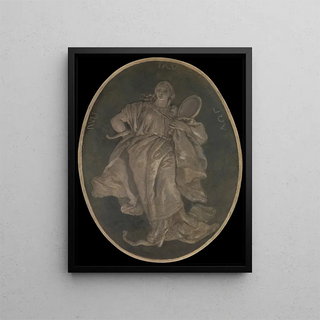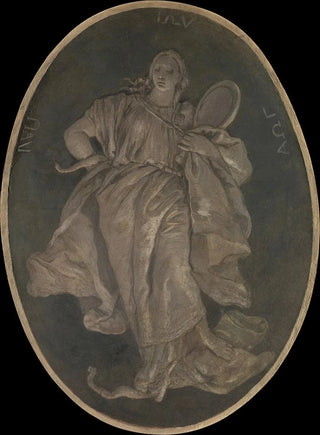Art print | Allegorical figure representing Prudence - Workshop of Giovanni Battista Tiepolo


View from behind

Frame (optional)
In the captivating world of baroque art, the "Figure allégorique représentant la Prudence" emerges as a vibrant symbol of wisdom and discernment. This artwork, attributed to the atelier of Giovanni Battista Tiepolo, embodies the essence of 18th-century humanist thought, where every detail is carefully crafted to evoke profound reflections on the human condition. The allegory of Prudence, often depicted as a female figure, invites viewers to contemplate the duality of knowledge and ignorance, as well as the winding path each person takes toward wisdom. By immersing oneself in the intricacies of this piece, one discovers a universe where art becomes the mirror of our own quest for understanding.
Style and uniqueness of the work
Tiepolo's style, characterized by unmatched lightness and fluidity, is fully expressed in this art print. The composition features vibrant colors and shimmering lights that seem to dance across the canvas, creating an almost ethereal atmosphere. The central figure, draped in delicate fabrics, is surrounded by symbolic elements that reinforce the message of prudence. Facial expressions and gestures of the characters are meticulously orchestrated, conveying a palpable emotion that captures the viewer’s attention. Every brushstroke reveals exceptional craftsmanship, demonstrating the skill of the artists from Tiepolo's atelier, who knew how to blend technique and sensitivity to bring captivating visual stories to life.
The artist and his influence
Giovanni Battista Tiepolo, an undisputed master of baroque painting, left his mark on his era with his innovative approach to light and color. Born in Venice, he drew inspiration from the artistic traditions of his hometown while reinterpreting them with unprecedented boldness. Tiepolo managed to charm the aristocrats of his time, and his works still adorn many palaces and churches across Europe today. His influence extends beyond his contemporaries; it has also spanned centuries, inspiring generations of

Matte finish

View from behind

Frame (optional)
In the captivating world of baroque art, the "Figure allégorique représentant la Prudence" emerges as a vibrant symbol of wisdom and discernment. This artwork, attributed to the atelier of Giovanni Battista Tiepolo, embodies the essence of 18th-century humanist thought, where every detail is carefully crafted to evoke profound reflections on the human condition. The allegory of Prudence, often depicted as a female figure, invites viewers to contemplate the duality of knowledge and ignorance, as well as the winding path each person takes toward wisdom. By immersing oneself in the intricacies of this piece, one discovers a universe where art becomes the mirror of our own quest for understanding.
Style and uniqueness of the work
Tiepolo's style, characterized by unmatched lightness and fluidity, is fully expressed in this art print. The composition features vibrant colors and shimmering lights that seem to dance across the canvas, creating an almost ethereal atmosphere. The central figure, draped in delicate fabrics, is surrounded by symbolic elements that reinforce the message of prudence. Facial expressions and gestures of the characters are meticulously orchestrated, conveying a palpable emotion that captures the viewer’s attention. Every brushstroke reveals exceptional craftsmanship, demonstrating the skill of the artists from Tiepolo's atelier, who knew how to blend technique and sensitivity to bring captivating visual stories to life.
The artist and his influence
Giovanni Battista Tiepolo, an undisputed master of baroque painting, left his mark on his era with his innovative approach to light and color. Born in Venice, he drew inspiration from the artistic traditions of his hometown while reinterpreting them with unprecedented boldness. Tiepolo managed to charm the aristocrats of his time, and his works still adorn many palaces and churches across Europe today. His influence extends beyond his contemporaries; it has also spanned centuries, inspiring generations of






